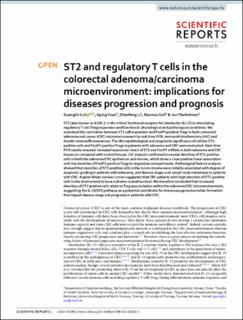| dc.contributor.author | Cui, Guanglin | |
| dc.contributor.author | Yuan, Aping | |
| dc.contributor.author | Li, Zhenfeng | |
| dc.contributor.author | Goll, Rasmus | |
| dc.contributor.author | Florholmen, Jon | |
| dc.date.accessioned | 2020-07-07T07:49:44Z | |
| dc.date.available | 2020-07-07T07:49:44Z | |
| dc.date.created | 2020-04-03T13:21:42Z | |
| dc.date.issued | 2020 | |
| dc.identifier.citation | Cui, G., Yuan, A., Li, Z., Goll, R. & Florholmen, J. (2020). ST2 and regulatory T cells in the colorectal adenoma/carcinoma microenvironment: implications for diseases progression and prognosis. Scientific Reports, 10: 5892. doi: | en_US |
| dc.identifier.issn | 2045-2322 | |
| dc.identifier.uri | https://hdl.handle.net/11250/2660896 | |
| dc.description.abstract | ST2 (also known as IL1RL1) is the critical functional receptor for interleukin (IL)-33 in stimulating regulatory T cell (Treg) expansion and function in physiological and pathological conditions. We examined the correlation between ST2 cell expression and FoxP3 positive Tregs in both colorectal adenoma and cancer (CRC) microenvironment by real-time PCR, immunohistochemistry (IHC) and double immunofluorescences. The clinicopathological and prognostic significance of cellular ST2- positive cells and FoxP3-positive Tregs in patients with adenoma and CRC were evaluated. Real-time PCR results revealed increased expression levels of ST2 and FoxP3 mRNAs in both adenoma and CRC tissues as compared with control tissues. IHC analysis confirmed increased densities of ST2-positive cells in both the adenoma/CRC epithelium and stroma, which show a close positive linear association with the densities of FoxP3-positive Tregs in respective compartments. Pathological feature analysis showed that densities of ST2-positive cells in the tumor stroma were notably associated with degree of dysplastic grading in patients with adenoma, and disease stages and lymph node metastasis in patients with CRC. Kaplan-Meier survival curves suggested that CRC patients with high densities of ST2-positive cells in the stroma tend to have a shorter overall survival. We therefore concluded that increased densities of ST2-postive cells relate to Treg accumulation within the adenoma/CRC microenvironment, suggesting the IL-33/ST2 pathway as a potential contributor for immunosuppressive milieu formation that impact disease stage and prognosis in patients with CRC. | en_US |
| dc.language.iso | eng | en_US |
| dc.publisher | Springer Nature | en_US |
| dc.rights | Navngivelse 4.0 Internasjonal | * |
| dc.rights.uri | http://creativecommons.org/licenses/by/4.0/deed.no | * |
| dc.title | ST2 and regulatory T cells in the colorectal adenoma/carcinoma microenvironment: implications for diseases progression and prognosis | en_US |
| dc.type | Peer reviewed | en_US |
| dc.type | Journal article | en_US |
| dc.description.version | publishedVersion | en_US |
| dc.rights.holder | © 2020 The Author(s) | en_US |
| dc.subject.nsi | VDP::Medisinske Fag: 700::Klinisk medisinske fag: 750::Onkologi: 762 | en_US |
| dc.subject.nsi | VDP::Medisinske Fag: 700::Klinisk medisinske fag: 750::Gasteroenterologi: 773 | en_US |
| dc.source.pagenumber | 12 | en_US |
| dc.source.volume | 10 | en_US |
| dc.source.journal | Scientific Reports | en_US |
| dc.identifier.doi | 10.1038/s41598-020-62502-0 | |
| dc.identifier.cristin | 1805198 | |
| dc.relation.project | Medical Research Program, Northern Norway Regional Health Authority: SFP-44-04 | en_US |
| dc.relation.project | Innovation Scientists and Technicians Troop Construction Projects of Henan Province: CXTD20150009 | en_US |
| dc.relation.project | Nature and Science Foundation of Henan Province: 182300410326 | en_US |

